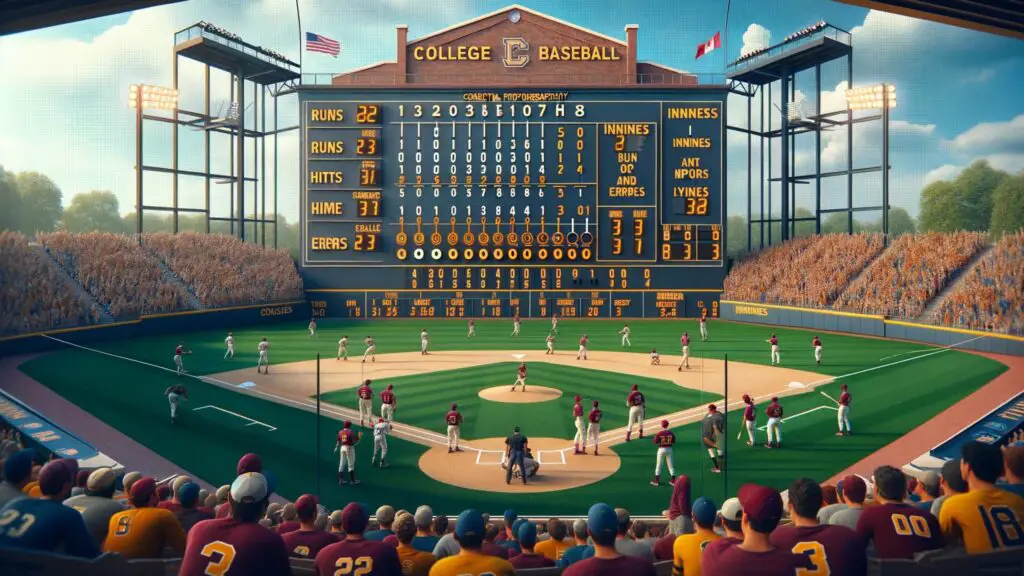
In this article:
Have you ever watched a thrilling college baseball game and wondered, “Just how many innings does a college baseball game have?”
Well, grab a bag of peanuts and keep that baseball cap on as we dive into the heart of the game!
Firstly, it’s important to understand what an inning is. An inning is a fundamental part of a baseball game during which one team bats and the other team fields.
Each inning is divided into two halves, the top, and the bottom, allowing both teams to bat and field.
In college baseball, a game typically consists of 9 innings. However, this can vary in the case of certain scenarios, such as rain delays, extra innings due to a tie, or mercy rules.
So, fasten your seat belts as we explore the exciting and unpredictable world of college baseball innings!
How Many Innings Are Played in a College Baseball Game
Have you ever wondered how many innings are involved in a college baseball game? Well, grab your mitt and cap. It’s time to dive into that question!
For the uninitiated, an inning in baseball represents a division of the game during which one team has a turn at batting and the other at fielding.
Standard College Baseball Game
In a standard college baseball game, there are typically 9 innings. Each inning is split into two halves; the visiting team bats in the first half (the top of the inning), and the home team bats in the second half (the bottom of the inning).
When diving into the complexities and nuances of baseball, it’s essential to understand not just the basic rules but also the deeper metrics and elements that make the game what it is.
In the context of college baseball, which typically consists of nine innings in a standard game, there are several key aspects that fans and players alike should be familiar with to fully appreciate the strategies and skills on display.
Among these are WHIP, WAR, and even the physical characteristics of the equipment used, such as the number of stitches on a baseball.
What if the Game is Tied?
If the game is tied after 9 innings, the teams will play extra innings until a winner is determined. There’s no limit to the number of extra innings that can be played, making for some potentially lengthy and nail-biting games!
Shortened Games
However, there are certain situations where a game might be shorter. For example, in bad weather, darkness, or a mercy rule, the game might end after 7 innings.
The mercy rule applies when one team leads by a significant number of runs, typically 10, after 7 innings.
So there you have it! College baseball games are typically 9 innings long but may vary due to exceptional circumstances or tied games.
No matter how many innings, one thing’s for certain – college baseball games are packed with excitement and suspense!
The Differences Between College Baseball Innings and Professional Baseball Innings
Now that we’ve got your attention let’s dive into the significant differences between college and professional baseball innings. One might think they’re identical, but there are distinct variations that all fans should know.
This knowledge can transform you from a casual spectator to an informed fan.
Number of Innings
In college baseball, there’s a standard nine-inning format like in professional baseball. However, some variations can occur in college play. Games might be shortened to seven innings in the case of a doubleheader.
The Pace of Play
While the number of innings may be the same, the pace of play can differ significantly. The NCAA implemented a 20-second pitch clock in 2015 to speed up college games, a feature not consistently present in professional baseball.
Extra Innings
When it comes to extra innings, college and professional baseball handle them differently. If a college game is tied after nine innings, the teams play additional innings until there’s a winner.
But unlike professional games, college baseball uses a tiebreaker rule in the 10th and subsequent innings to expedite the game’s conclusion.
Use of Aluminum Bats
Perhaps the most noticeable difference is the use of aluminum bats in college games, which can drastically change the dynamics of an inning.
These bats give an advantage to the hitter, as balls can be hit farther and harder than wooden bats used in professional games.
Whether you’re a seasoned fan or a rookie, understanding these differences can help you appreciate the game’s nuances at college and professional levels.
So, next time you’re at the ballpark, you’ll have a more profound understanding of the innings and their impact on the game’s rhythm.
How the Number of Innings in College Baseball Has Changed Over Time
For those who may not know, the standard number of innings in a college baseball game has not always been a steadfast rule.
The development of this aspect of the game reflects the evolution of baseball as a whole.
The Early Years
In the early days of college baseball, games were typically shorter. An average game lasts anywhere between five to seven innings. This was mainly due to the lack of artificial lighting, which limited play to daylight hours.
Transition Period
As the sport grew in popularity and infrastructure improved, games gradually lengthened. By the mid-20th century, college baseball games regularly ran for nine innings, bringing them in step with their professional counterparts.
The Current Rule
Today, the standard for college baseball is a nine-inning game. This has been upheld by the NCAA (National Collegiate Athletic Association) and is the most common format for college baseball across the US.
Exceptions to the Rule
However, there are exceptions to this rule. In cases of doubleheaders, games may be shortened to seven innings. Games may also be shortened due to weather conditions or extended due to a tie that needs breaking.
In conclusion, while the standard is nine innings, the actual number of innings in a college baseball game can vary depending on various circumstances.
What Happens in Extra Innings in College Baseball
Extra innings in college baseball? Oh, now we’re talking about heart-pounding excitement! Should a regular nine-inning game end in a tie, the teams will head into a bonus round, or as we commonly call it, “extra innings”.
So, what exactly happens in these extra innings?
The game continues, and it’s as thrilling as it sounds. The teams keep playing full innings, one at a time, until one has more runs at the end of an inning. It’s the ultimate battle of endurance, strategy, and skill.
There are, however, a few noteworthy rules:
- The NCAA introduced a new rule in 2020 for Division I college baseball, which allows for the start of each half-inning, starting with the 10th, with a runner on second base. This is meant to speed up the game and increase the team scoring chances.
- There’s also a rule that no new inning will start after a specific time, usually around midnight, to protect student-athletes’ welfare.
Extra innings can add a whole new layer of strategy and tension to the game. Will they play it safe? Or will they swing for the fences to end it all? Only time and a few extra innings will tell!
The Role of Pitch Counts in College Baseball Innings
Understanding the intricacies of college baseball can be a bit of a curveball, especially when it comes to the role of pitch counts.
In the thrilling banter and the clatter of bats, the pitch count often plays a crucial role in determining the game’s strategy.
What’s in a Pitch Count?
A pitch count in baseball refers to the total number of pitches a pitcher throws during a game. In college baseball, managing pitch counts effectively is a skill that often separates the great teams from the merely good.
The Significance of Pitch Counts
Pitch counts are significant because they are directly linked to a pitcher’s effectiveness and health. A higher pitch count can lead to fatigue, reduced performance, and increased risk of injury.
Therefore, college coaches must monitor pitch counts and make strategic decisions accordingly.
Guidelines for Pitch Counts in College Baseball
While there isn’t a hard and fast rule for the maximum number of pitches in college baseball, certain guidelines are generally followed.
Pitchers are usually limited to 100-120 pitches per game, depending on their stamina and the coach’s strategy. However, the exact number can vary greatly depending on the game situation.
The Impact on Innings
The number of pitches thrown directly influences the number of innings a pitcher can last. If a pitcher is efficient with his pitches, he can last nine innings.
However, if a pitcher throws many pitches per inning, his outing may be cut short.
Pitch Counts and the Bullpen
Managing pitch counts isn’t just about monitoring the starting pitcher. When a starter’s pitch count begins to climb, it’s usually a sign that a call to the bullpen is imminent.
This is where relief pitchers come into play, ready to step onto the mound and keep the game going.
Strategies for Pitching and Hitting in College Baseball Innings
When it comes to college baseball, the strategy for pitching and hitting is extremely crucial. Each inning presents an opportunity to change the game’s direction.
As a player, understanding these strategies can be your ticket to becoming a standout performer.
Strategies for Pitching
As a pitcher, your goal should be to keep the batter guessing. Mixing up fastballs, curveballs, and change-ups can significantly affect a batter’s timing.
Incorporating a variety of pitches makes you unpredictable and, therefore, more difficult to hit.
- Fastballs: This is the most common pitch. It’s all about speed and accuracy.
- Curveballs: This pitch involves a downward spin, causing the ball to drop as it approaches the plate.
- Change-ups: This slower pitch is designed to look like a fastball but delivered at a slower speed to confuse the batter.
Strategies for Hitting
The key to successful hitting lies in anticipation and rapid reaction. Understand the pitcher’s patterns and adjust your timing and swing accordingly.
- Watch the pitcher: Take note of the pitcher’s habits. Does he lean back more on a curveball? Does his grip change when throwing a fastball?
- Adjust your stance: Depending on the pitch, you might need to adjust your stance. For a fastball, stand deeper in the box; for a curveball, move up in the box.
- Swing with purpose: Every swing should have intent behind it. Aim to make contact and drive the ball into play.
Remember, practice makes perfect. These strategies are just a guide. The more you play, the more intuitive these decisions will become.
Baseball is, after all, a game of skill, strategy, and sometimes, a little luck.
Even the equipment used in baseball, such as the baseball itself, has fascinating details worth exploring. For instance, knowing How Many Stitches Are On A Baseball and the craftsmanship involved in its creation can enrich our appreciation of the game.
With exactly 108 double stitches, or 216 individual stitches, the baseball is a testament to the sport’s rich history and tradition. This detail, though small, is a tangible connection to the game’s past and its meticulous standards.
How Weather Can Affect the Number of Innings Played in a College Baseball Game
Have you ever wondered how the weather might affect the number of innings in a college baseball game?
It’s not something that many people think about, but weather can significantly impact the course of a game.
Impact of Rain
Rain is one of the biggest weather-related factors affecting the number of innings in a college baseball game. When it starts pouring, the game can be delayed or even canceled.
Under NCAA rules, if a game is called due to weather, it can be considered a complete game if five innings have been played (or 4.5 innings if the home team is leading).
Impact of Lightning
Lightning is another significant weather factor. NCAA rules mandate a suspension of play if there’s lightning within an eight-mile radius of the field.
The game can’t resume until 30 minutes after the last observed lightning strike.
Impact of Extreme Temperatures
Extreme hot and cold temperatures can also affect the number of innings. High temperatures can lead to player fatigue and an increased risk of heat-related illnesses.
On the other hand, cold temperatures can make the game uncomfortable for players, potentially affecting their performance and the overall course.
Impact of Wind
Finally, let’s not forget about wind. A high wind can alter the baseball trajectory, possibly leading to more home runs or strikeouts.
In extreme cases, windy conditions can make the game unsafe and result in a delay or cancellation.
So, while a standard college baseball game is scheduled for nine innings, Mother Nature sometimes has other plans!
The Impact of COVID-19 on College Baseball Innings
COVID-19 has thrown a curveball to the world of sports, and college baseball is no exception. The pandemic has drastically affected the number of innings played, among other things.
So, what does this mean for our beloved pastime?
The Reduction in Innings
Due to the cancellation and postponement of numerous games, the total innings played in college baseball have significantly reduced.
This has inevitably altered the rhythm and pace of the season, creating an unprecedented situation for players and fans alike.
The Impact on Training and Performance
Restrictions and health protocols have also impacted the training regimens of players. With less time on the field, players have had to get creative to maintain their skills.
Less practice time and fewer innings played have strained player performance.
The Adjustments Made
Despite these challenges, college baseball has shown resilience. Coaches and players alike have adapted to this new normal, leveraging technology for virtual training sessions and strategic planning.
Furthermore, measures are in place to gradually increase the number of innings as conditions improve.
Looking Forward
The impact of COVID-19 on college baseball innings is significant, but it’s not the end of the game.
As we navigate this pandemic, we hope to gradually return to the full nine innings, restoring the sport to its former glory. Until then, we continue to cheer on our college teams with unwavering support.
Famous College Baseball Games That Went into Extra Innings
Let’s dive into the annals of college baseball and dig out some of the most memorable games that stretched into extra innings.
These classic contests tested the players’ endurance and grit and kept the fans on the edge of their seats until the very end.
The 25-Inning Marathon: Texas vs. Boston College
In 2009, the University of Texas Longhorns and Boston College Eagles engaged in a record-breaking NCAA tournament game that lasted an astonishing 25 innings.
This test of stamina and willpower, which ended with Texas claiming a 3-2 victory, is still recognized as the longest game in the history of college baseball.
Omaha in Overtime: Vanderbilt vs. Virginia
The 2014 College World Series finals saw Vanderbilt Commodores and Virginia Cavaliers stretch the decisive game to 15 innings.
The Commodores eventually emerged as champions, etching their names in the books of baseball folklore.
Fresno State’s Epic Journey
Fresno State Bulldogs’ 6-5 win over the San Diego Toreros in 22 innings in 2018 is another unforgettable moment in the annals of college baseball.
The Bulldogs showcased exemplary resilience, eventually winning an epic victory after nearly six hours of play.
These games testify to college baseball’s unpredictable and thrilling nature, where the drama can extend well beyond the standard nine innings.
Indeed, these extra-inning spectacles often remain etched in the memories of baseball lovers for years to come.
How to Keep Score of Innings in College Baseball
So, you’re ready to dive into the exciting world of college baseball, but you’re not sure how to keep score of innings? Fear not, my friend! The process isn’t as complicated as it may seem at first glance.
Understanding the Basics
First, it’s important to understand what an inning is in baseball. Like in professional baseball, an inning in college baseball is a segment of the game divided into two halves.
In each half, one team bats while the other team fields. A full game consists of 9 innings.
The Scorebook
Keeping score of innings in baseball involves a scorebook. This record book allows you to note down the game’s progress. Each section of the book represents an inning, with two halves—one for each team.
Recording the Plays
Each player’s at-bat during an inning is recorded using specific symbols and numbers in the scorebook.
For instance, a single is denoted by ‘1B’, a double by ‘2B’, a triple by ‘3B’, and a home run by ‘HR’. Fielding positions are represented by numbers (1 for the pitcher, 2 for the catcher, and so on).
End of the Inning
When three outs have been made, the half-inning is over. In the scorebook, you then record the total runs, hits, and errors for that half-inning. Once both halves of the inning are completed, you’re ready to move on to the next!
With practice, keeping score of innings in college baseball becomes second nature. So grab your scorebook and head to the diamond—it’s time to play ball!

FAQs
How Many Innings in College Baseball?
In college baseball, a regulation game consists of 9 innings. Each inning is divided into two halves: the top and bottom. The top half is when the away team is batting, and the bottom is when the home team is up to bat. However, there are certain circumstances where the game may be shorter or longer than 9 innings. Let’s explore some of these scenarios.
Can a College Baseball Game Be Shorter Than 9 Innings?
Yes, a college baseball game can be shorter than 9 innings. Some games may be scheduled to last only 7 innings. This is often done to save time or accommodate other games or activities.
What is the Longest College Baseball Game Ever Played?
The longest college baseball game ever played lasted 25 innings. It occurred on May 30, 2008, between Texas and Boston College in the NCAA Baseball Tournament. The game lasted over seven hours before Texas eventually came out as the winner.
Is College Baseball Played for 7 or 9 Innings?
College baseball is typically played for 9 innings, similar to professional Major League Baseball rules. However, there may be exceptions where a game is played for only 7 innings if it is scheduled as such.
How is the Number of Innings Determined in College Baseball?
The number of innings in college baseball is determined by the game rules and regulations set by the NCAA (National Collegiate Athletic Association). A typical game consists of 9 innings, but it can vary depending on the situation and any specific rules or agreements in place.
What Happens If a College Baseball Game Goes Into Extra Innings?
If a college baseball game goes into extra innings, the game has not been decided within the standard 9 innings. The teams will continue playing additional innings until there is a winner. There is no limit on the number of innings that can be played, and the game can continue for as long as necessary to determine a winner.
Is There a Mercy Rule in College Baseball?
Yes, there is a mercy rule in college baseball. If a team has a substantial lead over their opponent after a certain number of innings, the game may be ended early. The specific mercy rule may vary depending on the league or tournament, but it is typically in place to prevent excessively lopsided scores and minimize further playing time.
Conclusion
And there you have it, folks! The good old game of college baseball is traditionally played over nine innings.
But remember, games can sometimes be shortened or extended due to weather or other unforeseen circumstances.
Still, the standard stands for Nine innings in a game, each inning serving as a unique chapter in college baseball’s unfolding narrative of competition and camaraderie.
In the case of a tie after the ninth inning, the game enters extra innings. There’s no limit to the number of extra innings that can be played – the game continues until one team is leading at the end of an inning. How’s that for a sporting cliffhanger?
So, whether you’re a player, coach, enthusiastic parent, or a fan cheering from the stands, remember that each inning counts.
Ultimately, it’s not just about how many innings in college baseball but about the moments that make each inning memorable. Play ball!






